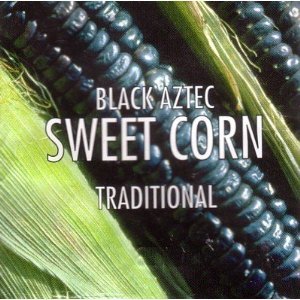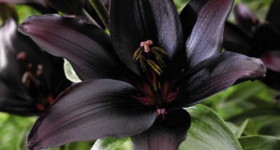Black Aztec Corn has a very long history as it is known to have been grown by the ancient Aztecs as far back as 2,000 years ago. It was first introduced into the seed trade and made its appearance in the seed company catalogs in the 1860’s and is considered to be a heritage or heirloom seed variety these days. Black Aztec corn is also referred to as “Black Aztec”, “Black Sweet”, “Black Sugar”, “Mexican”, and “Mexican Sweet”. Here we look at some great ways to use this corn variety, how to plant it, and how to successfully raise your own crop.
How to Use Black Aztec Corn
This corn variety grows on plants that reach heights of about six feet tall and produces seven inch ears. If picked while the kernels are still light in color, it can be eaten as a delicious sweet corn. If the ears are allowed to mature fully, the kernels become a bluish-black, gray-black, or black in color. If harvested at the fully matured stage, the ears can be dried and the kernels ground up and used for corn meal. Because of its interesting color, the dried ears also make attractive fall decorations when grouped into bunches of multi-colored ears of corn, known as Indian Corn.
Organic black Aztec corn seeds 25+ count
Where Does Black Aztec Corn Grow Best?
This type of corn grows best in areas where there is a temperate climate that receives plenty of rainfall. Black Aztec requires warm temperatures in order to germinate and grow properly. Corn should planted well after the danger of the season’s last frost has passed and when the ground temperature has reached at least fifty five degrees Fahrenheit. Plants will do best if planted in rich soil that is well drained and in areas that receive plenty of full sun. Although the corn will continue to grow in dry conditions and is drought tolerant, for the best possible crop and ears that produce moist, tender kernels, supplemental watering is necessary
Planting and Caring for Black Aztec Corn
Choose a location that receives full sun and where the soil is well drained. Mix two inches of compost into the top six inches of soil in the area where the corn is to be planted. Plant in rows, dropping three seeds together at once at intervals of nine to twelve inches apart. Cover the seed groupings with about an inch and a half of soil and water well after planting. To allow plants to pollinate properly, plant three of four short rows of corn about 30 to 36 inches apart from each other. Keeping the soil moist during the period when the plants are producing tassels for pollination is extremely important, as well as during the time when the kernels are ripening. Plants do best with about one inch of water per week, so if your growing area has not received adequate rainfall, water after the first top inch of soil has become dry.
Additional Requirement for Successfully Growing Black Aztec Corn
Aside from proper planting and watering, the corn will also require fertilizing and a bit of regular maintenance. Corn requires a large amount of nitrogen in the soil to grow properly, so it is essential to provide two applications of high nitrogen fertilizer to the plants during the growing season. Upon reaching twelve to fifteen inches tall, plants should be fertilized with a 46-0-0 fertilizer by spreading the fertilizer in a line about half a foot away from the base of the plant. Ratio is one half pound of fertilizer to every 100 square feet. Fertilizer should be raked into ground after spreading, and then the ground watered thoroughly. The next application should take place when the plants begin producing silk tassels. For the second application, use one fourth of a pound of fertilizer to 100 square feet. Weed the area around your corn regularly to prevent other weeds and plants from stealing the valuable nitrogen from the corn plants. Keeping the area weed free also eliminates hiding places for pesky insects and worms that might harm your crop.
In Case of Insect Infestation
People are not the only ones who love a tasty sweet corn variety, so do pests. The European corn borer, fall armyworm, corn rootworm, and corn earworm are some nasty insects that can damage your crop. If you notice any of these, place traps near the corn to trap them. This is usually enough to control a small infestation. For anything larger, an insecticide must be sprayed onto the plant leaves at intervals of every five days to kill insects off after they hatch from their eggs.












Speak Your Mind